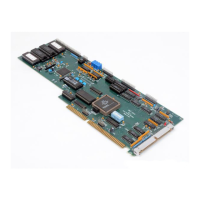DMC-1000 Chapter 7 Application Programming • 97
>= greater than or equal to
<> not equal
Subroutines
A subroutine is a group of instructions beginning with a label and ending with an end command (EN).
Subroutines are called from the main program with the jump subroutine instruction JS, followed by a
label or line number, and conditional statement. Up to 8 subroutines can be nested. After the
subroutine is executed, the program sequencer returns to the program location where the subroutine
was called unless the subroutine stack is manipulated as described in the following section.
Example - Using a Subroutine
Subroutine to draw a square 500 counts on each side. The square starts at vector position 1000,1000.
Instruction Interpretation
#M Begin main program
CB1 Clear Output Bit 1 (pick up pen)
VMXY Specify vector motion between X and Y axes
VP 1000,1000;VE;BGS Define vector position; move pen
AMS Wait for after motion trippoint
SB1 Set Output Bit 1 (put down pen)
JS #Square;CB1 Jump to square subroutine
EN End main program
#Square Square subroutine
V1=500;JS #L Define length of side, Jump to subroutine #L
V1=-V1;JS #L Switch direction, Jump to subroutine #L
EN End subroutine #Square
#L;PR V1,V1;BGX Subroutine #L, Define relative position movement on X and Y; Begin motion
AMX;BGY;AMY After motion on X, Begin Y, Wait for motion on Y to complete
EN End subroutine #L
Stack Manipulation
It is possible to manipulate the subroutine stack by using the ZS command. Every time a JS
instruction, interrupt or automatic routine (such as #POSERR or #LIMSWI) is executed, the
subroutine stack is incremented by 1. Normally the stack is restored with an EN instruction.
Occasionally it is desirable not to return back to the program line where the subroutine or interrupt was
called. The ZS1 command clears 1 level of the stack. This allows the program sequencer to continue
to the next line. The ZS0 command resets the stack to its initial value. For example, if a limit occurs
and the #LIMSWI routine is executed, it is often desirable to restart the program sequence instead of
returning to the location where the limit occurred. To do this, give a ZS command at the end of the
#LIMSWI routine.
Automatic Subroutines for Monitoring Conditions
Often it is desirable to monitor certain conditions continuously without tying up the host or DMC-
1000 program sequences. The DMC-1000 can monitor several important conditions in the
background. These conditions include checking for the occurrence of a limit switch, a defined input,
Artisan Technology Group - Quality Instrumentation ... Guaranteed | (888) 88-SOURCE | www.artisantg.com

